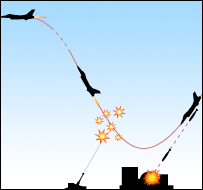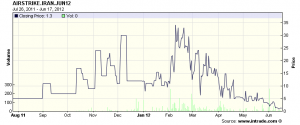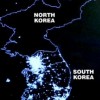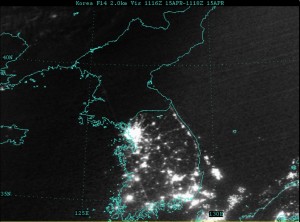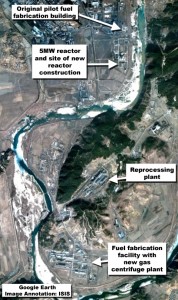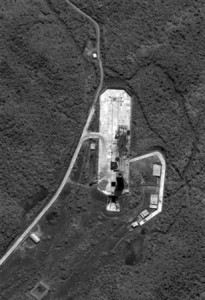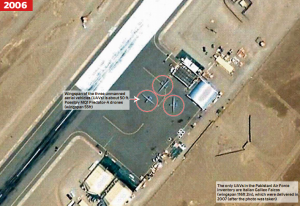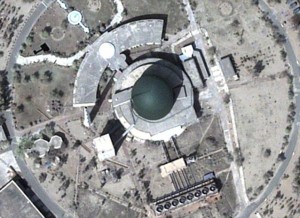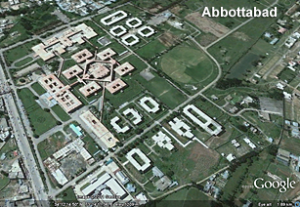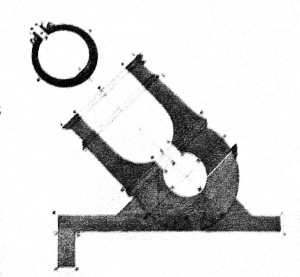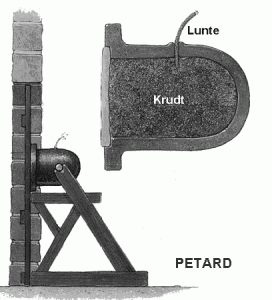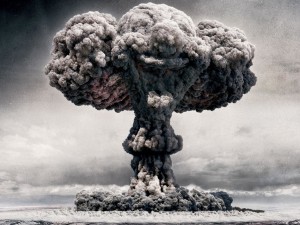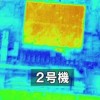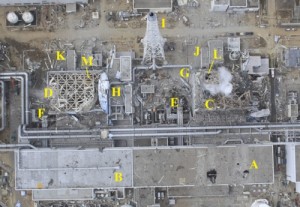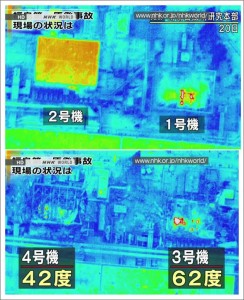First, of course, I have no idea. Second, who is/are “they” and what is “will”? A brief review on the eve of the next round of negotiations in Moscow.
The cast:
- Iran
- Israel
- The US
- The P5+G and the IAEA
(Some) Supporting players:
- The crowd
- The Fourth Estate
- The think tanks
- The US Congress
Iran
Will they capitulate in some way, to some degree, to pressure from outside agency (especially the P5+G, or, nominally, the IAEA)? Will they rattle the saber a bit more (perhaps a Shahab missile test, or the disclosure of another secret development site a la Fordow–i.e. the site near Qom)? This would have an enormous and stifling impact on negotiators. But it would be difficult; they’ve invested a lot in these sites. In a sense, even Fordow would have been assorted decoy in this situation.What credible threat can they make regarding the Strait of Hormuz? Or, to what extent are threats all you need?
BTW, Ahmadinejad is “retiring from politics” after completion of his term.
Don’t forget about Hezbollah in Mexico (as far as retaliation goes – could they attack the US directly in some way)? To cover my bases, here’s press from “the right” and “the left”… It’s a real possibility, but things would have to have gone pretty far. Then again, clearly “things going pretty far” is an unfortunate reality. There was a time, for instance, when a nuclear-armed North Korea was “intolerable”… and yet, unfortunately, here we are.
Israel
Will they strike independently? And, if they do, to what extent would such action be separable from that of the US? And, if so, what (this should go without saying, but this is not Osirak or Al Kibar)?
Ehud Barak has implied that returning to an enrichment ceiling of 3.5% migh be sufficient:
USOh, there… there’s no need for a fatwa if they stop enriching for 20%, if they start bringing it out of the country to a friendly mutually agreed state, the 20% enriched uranium, and 3.5% enriched uranium beyond a few hundred kilograms which is not enough for a single device…”
Were Israel to strike Iran, how separable would that action/the decisions that lead to it be from the US? Even if ideas of conspiracy between two countries were unfounded, it would be difficult to convince the Iranians that the case was otherwise – especially as communication channels would narrow in such a situation. And even if after the fact, how might US interests get engaged? In such a situation what degree of support from the US might be expected or forthcoming? A 2009 Brookings exercise simulated a unilateral Israeli attack on Iran, and the results might be informative:
But, the U.S. team did pledge the United States to Israel’s defense, and early on undertook numerous moves in support of that promise— deploying Patriot batteries and AEGIS warships to Israel, and installing new command and control systems to “net” the U.S. and Israeli air defense teams together.
P5+G and the IAEA
(the permanent members of the UNSC–not to be facile, but incidentally, the P5 were the ones who already had nukes–and Germany): What will they demand as part of a “negotiation”? That work at Fordow be suspended? Heightened access to/scrutiny of Fordow? Well these might be practical, other options, such as a complete suspension of any enrichment, would be unrealistic.
Also incidentally, it’s “+G” because Germany was part of the E3–back when the US wouldn’t talk to them.
The Crowd
Intrade is an interesting marker of what the crowd is thinking… Here’s what they thought about and overt Israeli or US attack by December 2011.
And now, here is what the by the end of June looks like:
The Fourth Estate
I don’t have much to say here, except to highlight the unique role Jeffrey Goldberg’s articles have played through the last several years. 2010. 2012.
Then there’s the latest Foreign Affairs issue with Kenneth Waltz’s cover article, “Why Iran Should Get the Bomb”.
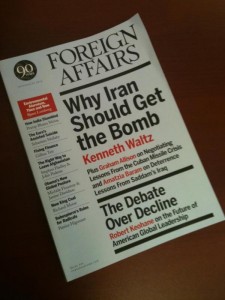
The Think Tanks
CNAS thinks a strike would be a bad idea.
CFR on where the “red lines” are or should be now.
The US Congress
Perhaps I’m out of gas; unfortunately I don’t feel like writing about Congress at the moment. [/pun]
How did we find out about these “secret” sites?
At no time in the last 15 years has any disclosure of the existence of Iranian enrichment facilities been their choice; in 2002 the Mujahedeen-e Khalq (MEK) “outed” the existence of the original enrichment facilities at Natanz (I use the scare quotes because, while this might constitute a public disclosure, there is little question that the intelligence community had awareness of this program). Iran disclosed the existence of the Fordow facility (this is the facility you’ll often hear of as buried deep within a mountain near the city of Qom) to the IAEA in 2009, but this was only after they become aware that elements of the Intelligence Community were already aware of it.
For more information on what Iranian enrichment to 20% would mean in practice, see this ISIS article.
Forever Overhead
Courtesy of Google Earth, ISIS has helped us follow developments at a number of Iranian facilities, thanks to satellites and overhead imagery. For example, see here
and here.
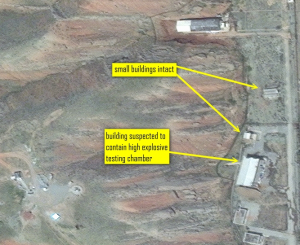
All the ISIS reports on Iran are excellent. Find them here.
More Iranian nuke porn here.
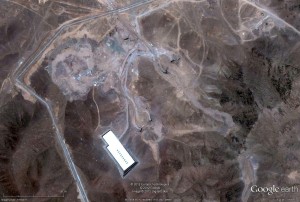
What Would a Successful Negotiation Look Like?
What would a compromise acceptable to all the active parties look like?
Again, Ehud Barak has suggested that a reduced maximum enrichment level of 3.5% might do the trick…
Sayed Mousavian (a former member of the Iranian negotiation team) also suggests something akin to a reduction in enrichment levels as well as an elimination of the more highly enriched levels:
I think that Mousavian is correct that allowing Iran some enrichment activity is a necessary condition of a deal. Once that right is established, Mousavian thinks that Iran would agree to a “zero stockpile” of uranium enriched to the potentially dangerous 20 percent level. As an interim “confidence-building measure,” Iran would export its stockpile of 20 percent uranium beyond what it needs for domestic civilian use.
I’d be hard-pressed to put it more succinctly than Stephen Walt:
From a purely strategic point of view, this situation is pretty simple. Iran is not going to give up its right to enrich uranium. Period. If the West insists on a full suspension, there won’t be a deal. It’s that simple. At the same time, the U.S. and the rest of the P5+1 would like to maximize the amount of time it would take Iran to “break out” and assemble a weapon. The best way to do that is to limit Iran’s stockpile of enriched uranium to concentrations of less than 5 percent. If Iran insists on keeping a large supply of 20 percent enriched uranium on hand, we’ll walk too… Yet it is these two comparatively powerful and nuclear-armed nations are insisting that Iran cannot under any circumstances have its own nuclear weapons — which Iran has repeatedly said it does not seek — and Israel’s leaders are declaring that Iran must give up even the potential to acquire them. I have no trouble understanding why the P5+1 and Israel might prefer such a world, but what I don’t understand is why they think Iran will ever agree to it. I mean, I’d like to live in a world where anyone making more than a $1 million per year had to send me ten percent of their income, but it would be foolish for me to plan my life on that basis.
A Note on the NPT and the Additional Protocols
I’ve argued in the past that we shouldn’t sneeze at the Nuclear Non-Proliferation Treaty (NNPT) for, among other reasons, there are a few other ideas of this scale that you’d ever get that many people to sign on to (currently 189 signers – they’re used to be 190, which included North Korea, but they withdrew… However, even in this case, there are protocols under which they can/can’t withdraw). Unfortunately, the NNPT sets no limits on the degree of enrichment a party can undertake. Clearly, it’s not enough. That’s why there are the Additional Protocols. The Additional Protocols, among other things, allow for greater degree of scrutiny and snap inspections by IAEA inspectors.
The Guns of July
As some of you know, I’ve long been an advocate of the “Iran as rational actor” line. I was to some degree vindicated by the 2007 NIE:
Our assessment that Iran halted the program in 2003 primarily in response to international pressure indicates Tehran’s decisions are guided by a cost-benefit approach rather than a rush to a weapon irrespective of the political, economic, and military costs.
At the moment, I’m fond of Kuperman’s formulation, “rational most–but not all–of the time”. But we’re entering serious “Guns of August” territory here.
Now I’m really out of gas. That’s the way it’ll stay for today. There are other Iran topics, but every time I list them something breaks the HTML–aforementioned “out of gas” state will keep them secret for now…


